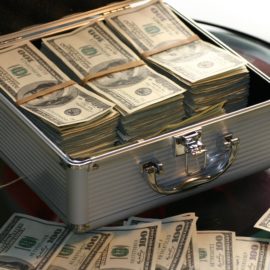

This article is an excerpt from the Shortform book guide to "Great by Choice" by Jim Collins and Morten T. Hansen. Shortform has the world's best summaries and analyses of books you should be reading.
Like this article? Sign up for a free trial here .
What is the 20 Mile March in business? What are some of its key characteristics?
To 20 Mile March in business means to hit specified targets year after year with a long-term view in mind. A good 20 Mile March has these five characteristics: 1) it specifies both lower and upper bounds; 2) it’s consistent; 3) it’s customized; 4) it’s achievable, and 5) it falls within a reasonable time frame.
This article spotlights the key characteristics of a good 20 Mile March and how to put it to work for your business.
What Is the 20 Mile March?
Comparison companies were relentless in their pursuit of growth in good times, which left them vulnerable in bad times. In contrast, 10Xers went on the 20 Mile March—they opted for consistent performance, in good times and bad.
To 20 Mile March means to achieve the set objectives each year with a long-term vision in mind. The name comes from the concept of reaching a destination by hitting 20 miles a day, no more, no less—no matter what. For example, if you were to walk 3,000 miles from California to Maine, you would walk 20 miles daily, whether it was sunny or stormy, whether you were in excellent form or feeling spent. Your steady pace would ensure that you had enough reserves to keep going, day after day, no matter what the conditions. If another traveler were to walk the same distance with a different tactic, pushing himself to go 40 miles on days when the weather was great, he would be too exhausted to keep going by the time the harsh winter arrives. He would end up sitting out the whole winter before recommencing in the spring, already having lost a lot of ground. By the time you reach Maine, he would’ve only gone halfway.
- Example: During the South Pole expedition, Amundsen never deviated from his target range of 15 to 20 miles a day, even on good days when the team could have gone 25 miles. He finished the expedition averaging 15.5 miles a day. On the other hand, Scott would push his team extra hard on good days, then sit it out when faced with gale-force winds. He did not survive the expedition.
Formula for a Good 20 Mile March
The 20 Mile March shows that slow and steady indeed wins the race. A good 20 Mile March is characterized by the following:
1. It specifies both lower and upper bounds. 10X companies did everything they could to meet targets year after year—no excuses—and these targets had both a minimum and a maximum. The minimum target, or the lower bound, was realistic enough so that a company could achieve it even during hard times, albeit with tremendous effort. The maximum, or the upper bound, was the farthest a company allowed itself to go, even when conditions were favorable.
Having upper bounds requires immense self-control. You have to hold back even when you can push a little harder, even when competitors are growing faster, even when Wall Street is putting on the pressure. This keeps you from overextending yourself or becoming too weak to face unexpected challenges. It’s just like Amundsen sticking to his 15-to-20-mile range.
- Example: Under CEO John Brown, Stryker’s target was a 20 percent net income growth every year. For 16 out of 19 years, Stryker hit this consistently and didn’t go above 30 percent. With this steady pace, a dollar invested in Stryker in 1979 was worth 350 times more by 2002. Meanwhile, Stryker’s comparison company USSC aggressively pursued growth, banking on and investing heavily in new technology. It grew 248 percent in three years, but this explosiveness was short-lived. The company was beset with issues like healthcare reform and strong competitors, and revenues fell. Things got so dire that by 1998, USSC was acquired by Tyco.
2. It’s consistent. Research shows that 10X companies didn’t meet their target 100 percent of the time. But on the rare occasion when they did miss the mark, they immediately did what needed to be done to get back on course.
3. It’s customized to the enterprise. The 20 Mile March isn’t one-size-fits-all. While a 20 percent lower bound for net income may make sense for a company like Stryker, it might not apply to your company. Don’t rely on outside factors to dictate your metrics and instead come up with performance markers that make sense for your organization. They might even be non-financial—for a church, it could be congregation size; for a school, it might be student performance.
4. It’s achievable through your own actions, not reliant on outside factors. 10Xers don’t sit around waiting for conditions to change in their favor. They know that there are many things they can’t control, like government regulations, technological advancements, and global competition, so they take action by controlling what they can control.
- Example: Alice Byrne Elementary School in Yuma, Arizona was well below state averages when it came to third-grade reading. They had limited resources, which they had no control over, and so they trained their attention on the things that they did have control over. By sticking to a stringent program involving close instruction, assessment, and intervention, the school was eventually able to raise its reading performance to 20 points above state averages.
5. It falls within a reasonable time frame. A too-short 20 Mile March exposes you to greater risk, while a too-long one won’t make enough of an impact.
Why the 20 Mile March Works
There are three reasons 20 Mile Marching leads to success:
- It makes you more confident. Forget motivational emails and pep rallies—there’s nothing quite like a win in the face of challenging circumstances to boost your confidence. When you see what your enterprise can accomplish despite conditions outside of your control, you take responsibility for your own success.
- It girds you for disruptive events. Comparison companies that pushed for maximum growth when times were good ended up depleting their resources, resulting in big setbacks when they ran into turbulence. In contrast, all 10X winners saw turbulence as their time to shine—they always outperformed comparison companies during difficult times.
- It keeps you in control. Natural disasters, financial markets, regulation changes—so many things are out of your control. But the 20 Mile March gives you a clear direction and purpose. It provides you with a beacon of light when everything around you is a swirl of chaos and uncertainty.
Example of a 20 Mile Marcher
Southwest Airlines’ 20 Mile March kept them stable even through the industry downturn in the 1990s and after 9/11 by:
- Specifying lower bounds and upper bounds, and remaining consistent. They pushed themselves to be profitable year after year, but they also put a cap on growth: In 1996, despite hundreds of cities seeking to enlist Southwest’s services, the company only expanded to four cities. They didn’t sacrifice long-term success for short-term growth.
- Having no excuses. The airline industry faced so many issues, from deregulation to strikes to fuel crises. While other airlines furloughed thousands of people and filed for bankruptcy, Southwest soldiered on and remained profitable for an impressive 30 years.
Exercise: Determine Your 20 Mile March
Build an enterprise that lasts by beginning your 20 Mile March.
What is your goal for the next 15 to 30 years?
How can you break down this goal into a 20 Mile March? What is a consistent target that you will aim to hit year after year?

———End of Preview———
Like what you just read? Read the rest of the world's best book summary and analysis of Jim Collins and Morten T. Hansen's "Great by Choice" at Shortform .
Here's what you'll find in our full Great by Choice summary :
- How you can make the choice to be great, no luck needed
- Why certain assumptions about great leaders are actually myths
- How some companies are 10X more successful than their competitors






